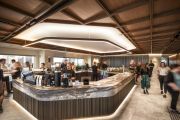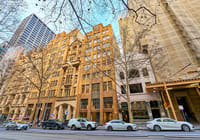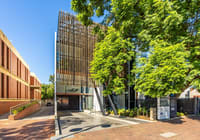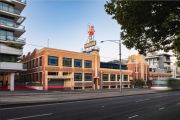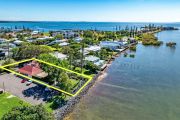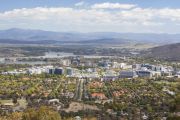
How to spend $10m retrofitting a D-grade office building
Private owners who want to refurbish and enhance low-grade office towers face a tougher job than many people realise, says the owner of a Melbourne commercial building who’s just completed a $10 million upgrade.
Designer Lou Weis, who co-owns the 11-floor, 3400-square-metre building at 124 Exhibition Street in the CBD, said they only embarked on the major renovation of their 1971 building after not being able to sell it for a price they were prepared to accept.

Even then, the cost of the overhaul was significant. It included upgrading the electrical system and replacing the entire western facade, giving that side of the building operable windows that allowed cross-ventilation from the heritage windows on the other side.
“We really, really didn’t want to do it,” said Weis, the founder of consultancy Broached Commissions. “It cost more than we were expecting.”
But it worked. Since completion in late 2023, new office tenants occupy 65 per cent of the building and are prepared to pay more for the new facilities and amenity.
“We’ve gone from being the cheapest building in the east end of Melbourne to hitting market rates, between $640 and $740 per square metre,” said Weis, who oversaw the renovation with his brother Tao.
But upgrading the 50-year-old building was an ordeal for the Weis family and co-owner Kevin Milstein that few private owners can take on. Weis says his family was able to raise the capital by selling other assets, including regional supermarket properties, which not all owners can do.
Other requirements made it harder. If a private building surveyor recommends to the council that more than 50 per cent of a building be changed, then the whole structure has to be upgraded to meet current code compliance.
In addition, corridor widths at 124 Exhibition Street didn’t meet current guidelines, but in many cases, couldn’t practically be widened.
“I seriously doubt many boutique multi-level buildings from the 1970s or before can meet all the contemporary codes and still be an affordable refurbishment,” he said.
The tower is not heritage-protected and while they could have put up a new building twice the height, the soaring costs of capital, labour and materials ruled out the construction of a new tower.

The hurdles point to a wider problem – that Australia’s commercial property industry doesn’t have the skills to retrofit the existing building stock for a changing time and wider range of uses.
While more common overseas, this has been done successfully in Australia. The former local office of Paramount Studios at Paramount House, 80 Commonwealth Street in Sydney’s Surry Hills, now holds a cinema, hotel and office.
But the Australian property industry had to be “more adventurous” around mixed-use city buildings, he said.
“Most developers and agents are still operating around a model of simple office design, fit-out and forget until rent renewals are due.”
To respond to the growth in agile work practices that resulted in more people working from home and other remote locations, a more dynamic idea of the office was required, but the commercial industry struggled to adapt, he said.
“We’ve had conversations with developers about this, but they end up reverting to the simpler old-fashioned model of incentives and standard lease deals,” he said.
The challenge is greatest in Melbourne, where a new report by commercial real estate agency JLL says the city has 1.8 million square metres of office space at risk of becoming obsolete as a result of rising environmental standards, changing work patterns and shifting tenant preferences.
The volume of office space needing upgrades in Melbourne – at an estimated total capital expenditure of $5.2 billion – beat Sydney, with 1.7 million square metres of at-risk space that required $4.9 billion in investment, as well as Brisbane, where the equivalent space and estimated cost was 700,000 square metres and $2 billion respectively, the report said.
“The investment case for comprehensive retrofits is compelling despite higher initial capital requirements,” JLL’s head of project and development services Alan McKay said.
“By retaining existing structures, owners can save between 30 and 40 per cent compared to demolition and rebuilding, while substantially improving asset performance and marketability.”
The refurbishment of 124 Exhibition Street has halved their ground level rental income by turning almost two-thirds of the area into a bike store, bin room and end-of-trip facilities designed by March Studio, the long-term architecture firm for upmarket cosmetic brand Aesop.

The owners couldn’t fully electrify the building as the substation built into it couldn’t draw enough electricity to power a fully tenanted building.
Utility CitiPower would have charged $30,000 for a plan that would have merely indicated whether the building could be upgraded to all-electric. If it could, the upgrade would have cost several hundreds of thousands of dollars and taken years to implement, Weis said.
He is still holding out hope of getting rid of the gas in the building, but needs to boost the occupancy rate from the current 65 per up to 80 per cent first. “It’s fine for residences but when you’re talking about refurbishing buildings, there all sorts of limits.”

